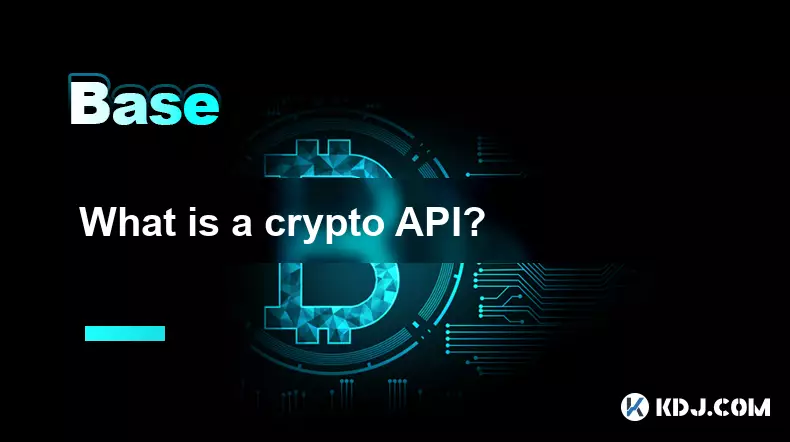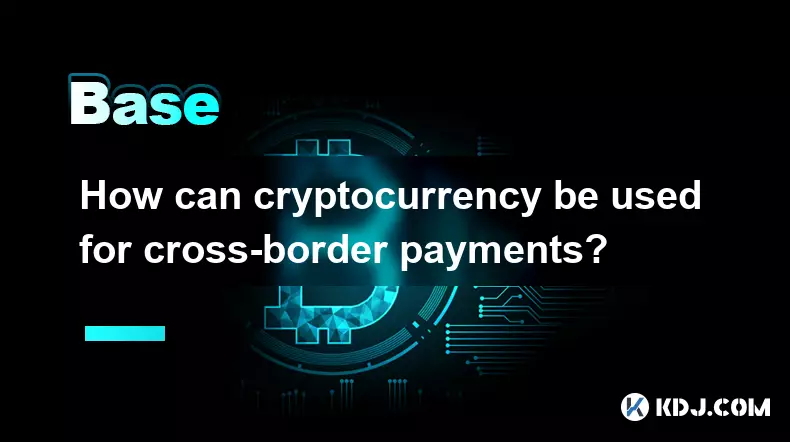-
 bitcoin
bitcoin $109523.663807 USD
-0.13% -
 ethereum
ethereum $4019.526508 USD
2.06% -
 tether
tether $1.000482 USD
0.00% -
 xrp
xrp $2.776815 USD
0.18% -
 bnb
bnb $958.942396 USD
0.12% -
 solana
solana $204.294698 USD
3.84% -
 usd-coin
usd-coin $0.999693 USD
0.00% -
 dogecoin
dogecoin $0.232115 USD
2.09% -
 tron
tron $0.338028 USD
0.84% -
 cardano
cardano $0.790920 USD
1.50% -
 hyperliquid
hyperliquid $44.871443 USD
5.60% -
 ethena-usde
ethena-usde $1.000322 USD
0.04% -
 chainlink
chainlink $21.034165 USD
2.60% -
 avalanche
avalanche $28.794831 USD
-0.54% -
 stellar
stellar $0.360466 USD
1.24%
What is a crypto API?
Crypto APIs bridge blockchain networks and apps, enabling developers to securely access real-time data, interact with smart contracts, and build scalable dApps without running full nodes.
Sep 12, 2025 at 09:18 am

Understanding the Role of Crypto APIs in Blockchain Ecosystems
1. A crypto API, or cryptocurrency application programming interface, serves as a bridge between blockchain networks and external applications. It enables developers to interact with blockchain data without running their own nodes. By sending HTTP requests, applications can retrieve transaction details, check wallet balances, and broadcast new transactions.
2. These APIs are essential for building decentralized applications (dApps) that require real-time access to blockchain data. They allow platforms like exchanges, wallets, and analytics tools to stay synchronized with the latest network activity. Without crypto APIs, each service would need to maintain its own infrastructure to parse and store blockchain information.
3. Major blockchain platforms such as Ethereum, Bitcoin, and Binance Smart Chain offer official or third-party APIs to facilitate integration. For example, Ethereum’s JSON-RPC API allows developers to query smart contract states, estimate gas fees, and deploy new contracts programmatically.
4. Security is a critical consideration when using crypto APIs. Since they expose sensitive data and transaction capabilities, proper authentication and rate limiting are necessary. Many providers use API keys, OAuth tokens, or IP whitelisting to control access and prevent abuse.
5. Some crypto APIs specialize in specific functions, such as price feeds, historical data analysis, or mempool monitoring. These niche services cater to traders, analysts, and developers who need granular insights into market behavior and network congestion.
Types of Crypto APIs and Their Applications
1. Node-based APIs provide direct access to blockchain nodes and are often used for reading and writing data on the ledger. They support methods like getBlock, sendTransaction, and call, which are fundamental for interacting with decentralized networks.
2. Indexing APIs aggregate and organize blockchain data into searchable databases. Services like The Graph or Alchemy’s enhanced APIs allow querying of token transfers, NFT ownership, and DeFi interactions using GraphQL or REST endpoints.
3. Price and market data APIs deliver real-time cryptocurrency valuations from multiple exchanges. Platforms such as CoinGecko and CryptoCompare use these APIs to power dashboards, trading bots, and portfolio trackers with up-to-date pricing information.
4. Wallet and identity APIs enable user authentication and transaction signing through non-custodial solutions. Web3Auth and WalletConnect use such interfaces to let users log in and approve transactions using their personal wallets.
5. Blockchain explorer APIs, like those offered by Etherscan or Blockchain.com, allow developers to fetch transaction histories, verify smart contracts, and monitor address activity. These tools are widely used in compliance, auditing, and forensic analysis.
How Developers Integrate Crypto APIs into Projects
1. To begin integration, developers typically register for an API key from a provider like Infura, QuickNode, or Moralis. This key authenticates requests and often determines usage limits and service tiers.
2. Most crypto APIs follow REST or WebSocket protocols, allowing compatibility with standard web development tools. REST is used for one-time queries, while WebSockets enable live updates for events like block confirmations or price changes.
3. Libraries such as Web3.js, Ethers.js, and Web3.py abstract API interactions, simplifying the process of connecting to Ethereum and other EVM-compatible chains. These libraries handle serialization, signing, and network communication behind the scenes.
4. Developers must handle errors and edge cases, such as failed transactions, stale data, or rate-limiting responses. Implementing retry logic, caching mechanisms, and fallback nodes ensures reliability in production environments.
5. Testing is crucial before deploying API-dependent features. Many providers offer testnet access, allowing developers to simulate transactions and verify functionality without risking real funds.
Frequently Asked Questions
What is the difference between a public and private crypto API?Public crypto APIs are openly accessible and often free for basic usage, allowing anyone to query blockchain data. Private APIs are restricted to authorized users, typically through API keys or enterprise agreements, and may offer higher performance, dedicated support, and access to proprietary data.
Can crypto APIs be used to create new cryptocurrencies?Crypto APIs themselves do not create new cryptocurrencies. However, they can interact with smart contract platforms to deploy token contracts based on standards like ERC-20 or BEP-20. The actual creation occurs through code deployment on the blockchain, which APIs can facilitate by sending signed transactions.
Are crypto APIs vulnerable to downtime or manipulation?Yes, centralized API providers can experience outages or become targets for attacks. Relying on a single source introduces risk. To mitigate this, developers often use redundant providers, decentralized API networks like Chainlink, or run their own nodes for critical operations.
How do rate limits work in crypto APIs?Rate limits restrict the number of requests a user can make within a given time frame, such as 100 requests per minute. Exceeding these limits may result in delayed responses or temporary blocking. Providers enforce these rules to maintain service stability and prevent abuse.
Disclaimer:info@kdj.com
The information provided is not trading advice. kdj.com does not assume any responsibility for any investments made based on the information provided in this article. Cryptocurrencies are highly volatile and it is highly recommended that you invest with caution after thorough research!
If you believe that the content used on this website infringes your copyright, please contact us immediately (info@kdj.com) and we will delete it promptly.
- XRP, Bitcoin Price Predictions: Decoding the Crypto Crossroads
- 2025-09-28 08:25:12
- ChatGPT, Crypto, and Crystal Balls: Predictions for a Wild 2025
- 2025-09-28 08:45:12
- Crypto Clash: Can Kaspa and Pi Coin Compete in a Remittix World?
- 2025-09-28 08:45:12
- Riding the Floki Wave: Gauging Gains with Social Engagement and Bottom Signals
- 2025-09-28 08:25:12
- Crypto 2025: MoonBull Charges Ahead, Leaving Pepe and Mog in the Dust
- 2025-09-28 08:50:12
- Sui Price, Toncoin Developments, Remittix ICO: What's the Buzz?
- 2025-09-28 08:50:12
Related knowledge

What are some common methods of cryptocurrency market manipulation?
Sep 27,2025 at 02:55am
Wash Trading and Its Impact on Market Perception1. Wash trading involves an individual or entity simultaneously buying and selling the same cryptocurr...

How do I read a cryptocurrency whitepaper?
Sep 27,2025 at 05:54am
Understanding the Structure of a Cryptocurrency Whitepaper1. Begin by identifying the executive summary, which outlines the project’s core vision and ...

Can I recover lost cryptocurrency?
Sep 25,2025 at 08:18am
Understanding the Nature of Cryptocurrency Loss1. Cryptocurrency operates on decentralized networks, meaning there is no central authority to reverse ...

How do I choose a cryptocurrency investment strategy?
Sep 27,2025 at 03:55pm
Understanding Risk Tolerance in Crypto Investing1. Assessing personal risk tolerance is a foundational step when entering the cryptocurrency market. V...

How can I earn passive income from cryptocurrency?
Sep 23,2025 at 10:18am
Staking Cryptocurrencies for Regular Returns1. Many blockchain networks operate on a proof-of-stake (PoS) consensus mechanism, allowing users to earn ...

How can cryptocurrency be used for cross-border payments?
Sep 28,2025 at 01:36am
Efficiency in International Transactions1. Cryptocurrency enables near-instant settlement across borders without relying on traditional banking interm...

What are some common methods of cryptocurrency market manipulation?
Sep 27,2025 at 02:55am
Wash Trading and Its Impact on Market Perception1. Wash trading involves an individual or entity simultaneously buying and selling the same cryptocurr...

How do I read a cryptocurrency whitepaper?
Sep 27,2025 at 05:54am
Understanding the Structure of a Cryptocurrency Whitepaper1. Begin by identifying the executive summary, which outlines the project’s core vision and ...

Can I recover lost cryptocurrency?
Sep 25,2025 at 08:18am
Understanding the Nature of Cryptocurrency Loss1. Cryptocurrency operates on decentralized networks, meaning there is no central authority to reverse ...

How do I choose a cryptocurrency investment strategy?
Sep 27,2025 at 03:55pm
Understanding Risk Tolerance in Crypto Investing1. Assessing personal risk tolerance is a foundational step when entering the cryptocurrency market. V...

How can I earn passive income from cryptocurrency?
Sep 23,2025 at 10:18am
Staking Cryptocurrencies for Regular Returns1. Many blockchain networks operate on a proof-of-stake (PoS) consensus mechanism, allowing users to earn ...

How can cryptocurrency be used for cross-border payments?
Sep 28,2025 at 01:36am
Efficiency in International Transactions1. Cryptocurrency enables near-instant settlement across borders without relying on traditional banking interm...
See all articles










































































